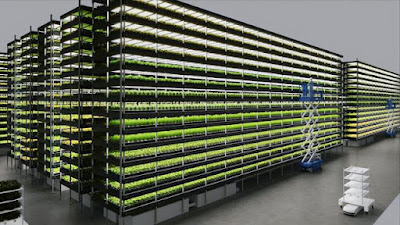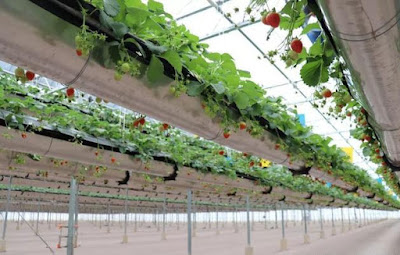Vertical farming is becoming more and more popular, whether it is smart greenhouses, container planting, abandoned factory buildings, or even underground basements, it is a relatively good choice. Focus on greenhouse engineering technology and serve modern agriculture. As technology has changed, improved and improved every aspect of our lives, it's no surprise that vertical farming has also changed how and where we grow crops and other commercially grown plants. As climate change alters weather patterns, growing crops indoors is becoming a viable and profitable option. If reproduced, please keep the copyright information.

Vertical farming is the practice of growing crops in vertically stacked layers. It typically includes controlled environment agriculture, designed to optimize plant growth, and soilless cultivation techniques, such as hydroponics, aquaponics, and aeroponics. By providing fresh local produce, vertical farming increases food production and expands agribusiness. As the world's population continues to expand, it is expected that by 2050, two out of every three people will live in metropolitan areas. Growing fresh vegetables near urban areas helps meet growing food demands in an environmentally sustainable way. Reducing the time it takes to transport produce to cities can reduce greenhouse gas emissions and provide more nutrient-dense vegetables while saving valuable resources like water and fertilizer. Let's take a look at how vertical farming is changing the way crops are grown.
Vertical farming
Vertical farming technology enables vertical farmers to monitor every environmental condition imaginable. But monitoring is only the first step. To get the most out of vertical farming technology, you need to connect equipment to operating systems to automate processes and provide insights into your data. Actionable insights provide a more straightforward approach to accurately predict yields. Let’s take a look at the technical areas available for vertical farming.
Monitoring
Collecting data starts with monitoring the most important aspects of controlled environment growing using sensors placed throughout the growing operation. Temperature, soil moisture levels, humidity, EC, light and carbon dioxide levels are fundamental points of monitoring. Connect these sensors to unlock the potential of your device.
Control
Industrial IoT controllers provide the ultimate smart farm experience, with the processing power to coordinate hundreds of smart devices throughout the indoor growing process. Smart Motor Controllers allow you to write rules from your smartphone to trigger timers, schedules, open vents, and more. You can even use the Crop Guidance Guide to create rules to guide the growth of your plants. You can read more about crop steering here.
Analytics
Connecting your equipment and using a top operating system will give you a clear view of your farm data. It provides meaningful insights through dozens of data visualizations. Most offer Excel integration to share data with your team. Vertical farming method of growing crops in piles. It combines controlled environment farming to optimize plant growth and utilize soilless farming techniques such as hydroponics, aquaponics or aeroponics. Next let's look at the benefits of vertical farming.
Vertical farming benefits
1. Year-round crop production
Vertical farming, because it is not weather dependent, can achieve consistent crop production year-round without being affected by adverse weather conditions. Growing in a safe, climate-controlled environment enables repeatable and programmable crop production. Technology allows automation to reduce harvest time and increase yields without compromising taste or quality.
2. Space rationalization
Traditional farms require fertile arable land and a lot of arable land. Vertical farming can be designed and built in any climate or place, regardless of weather conditions or extreme temperatures. Vertical farming allows you to achieve higher productivity in a relatively small space. Depending on the crops you grow, the vertical farming productivity per mu is 10-20 times that of traditional ordinary farming.
3. More sustainable than soil farming
Greenhouse vertical farming can be more environmentally friendly than farming because it reduces the operating costs required for farming equipment. While heating energy bills can be high, solar energy can help mitigate these environmental costs. Furthermore, the three-dimensional planting density is relatively large, and the cost is negligible and acceptable. Vertical farming helps improve biodiversity because it does not cause surface disturbance and reduces a range of soil problems such as pests and diseases. This helps the crop populations living in and around the farm to thrive.
4. Reduce resource waste
Vertical farming When properly managed and using the proper methods, growing crops in vertical farming offers the opportunity to eliminate the need for pesticides. Pests cannot easily enter a controlled environment to cause infestation, and fungal diseases cannot survive humidity control. Vertical farming, especially those that use hydroponics, also uses much less water than conventional farms. Water is recycled and almost no water is wasted.
5. Reduce shipping costs
Vertical farming Growing crops close to where customers live is a huge agricultural benefit. It reduces transportation costs, CO2 emissions and reduces the need for refrigerated storage making produce fresher and more profitable.
6. Reduce labor costs
Fully automatic indoor growing systems and greenhouses for vertical farming do not require a lot of manual labor for successful year-round production. But staff are still required to register crops and make sure the equipment is working properly, and very few people are needed to manage the growing environment.
Finally, Agricultural Big Data Internet Innovation Enterprise provides a platform with artificial intelligence capabilities and machine management that can accurately predict the size of your harvest. The output can be really calculated, and order-based sales can be realized.









